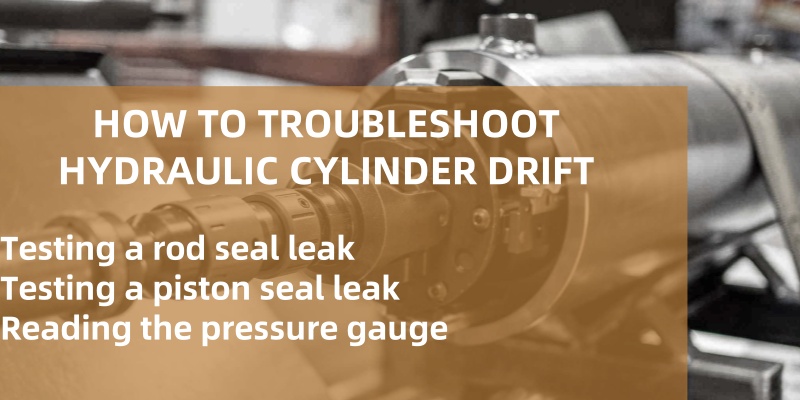How to Prevent Hydraulic Cylinder Drift
Introduction:
Hydraulic cylinder drift occurs when a cylinder moves unintentionally, even when control valves are in the neutral position. This issue can lead to operational inefficiencies, safety hazards, and potential equipment damage. Preventing cylinder drift involves addressing common causes such as internal leaks, worn seals, or faulty control valves. At Aisoar, a leading manufacturer of hydraulic cylinders and systems, we provide high-quality products designed to minimize drift and ensure reliable performance in your machinery.
What is hydraulic cylinder drift?

Hydraulic Cylinder Drift PreventionHydraulic cylinder drift is a problem that arises between the piston, rod, and hydraulic fluid pressure within a cylinder. When a seal fails and fluid begins to seep, it creates a balanced level of pressure on both sides of the piston throughout the cylinder chamber. Typically, pressure levels vary with the machine's actions. When oil pressure within the hydraulic cylinder stabilizes evenly, drift will occur.
During normal operation, the rod and piston in a hydraulic cylinder adjust fluid volume, using seals to maintain consistent pressure. Hydraulic lock occurs when the cylinder remains stationary in various positions. Conversely, hydraulic cylinder drift is when the cylinder unintentionally moves downward during operation, causing slow, irregular movements and inability to hold loads over time. This issue affects machinery like excavators and cranes, compromising safety and productivity. Troubleshooting is straightforward, with replacement parts readily available, and proactive measures can prevent future drift.
Seal Wear or Damage: When seals around the piston or rod deteriorate or fail, hydraulic fluid can leak, leading to uneven pressure within the cylinder. This pressure imbalance causes the cylinder to “drift” or move unintentionally.
What causes hydraulic cylinder drift?
Internal Leakage: Internal leaks within the cylinder or through control valves allow fluid to bypass the piston, leading to equalized pressure and drift.
Valve Malfunctions: Control valves that do not close completely can let fluid pass when it shouldn’t, creating unintentional movement.
Thermal Expansion: Temperature changes can cause oil expansion, slightly moving the piston if seals aren’t perfectly intact.

Common signs of hydraulic cylinder drift include:
Unintended Movement: The cylinder slowly moves or sinks when the machine should be stationary, often noticeable when lifting or holding loads.
Inconsistent Load Holding: Difficulty maintaining load position, especially when the cylinder “drifts” downward underweight, signaling a pressure imbalance.
Irregular Movements: The cylinder may experience sluggish or jerky motions, indicating internal fluid leakage or valve issues.
Reduced Precision: Articulations in equipment become less responsive, impacting control and stability.
Increased Cycle Times: Operations take longer as drift impacts the speed and efficiency of hydraulic functions, reducing productivity.
Best Ways to Prevent Hydraulic Cylinder Drift
The best way to prevent hydraulic cylinders from drifting is through regular maintenance. Whether you're in the marine, pharmaceutical, manufacturing or construction industries, maintaining your equipment is key.
Inspecting the components of every machine in your fleet, including hydraulic cylinders and their seals and fluids, should be part of your daily routine. Check for corrosion, inspect rods, check the condition of mounts and pins, check for leaks, and check for general wear and tear. It is also important to use a quality filtration system and monitor load capacity levels and speeds as you work.
Diagnose the problem as soon as you see signs of cylinder drift. Is the culprit a leaking piston valve or rod valve? Is the machine running on contaminated oil? Replacing parts and fluids immediately will help prevent more serious and costly damage later and reduce downtime.
The cause and prevention of cylinder drift also depends on the use of specialized cylinders. While generic solutions can get the job done, you need to invest in parts that match the make and model of your machine and application. Installing cylinders that are built specifically for your equipment allows it to perform at its highest level and continue to operate for a long period of time. Specialized cylinders are more efficient and less prone to failure.

AISOAR HYDRAULIC CYLINDERS
Hengxin Mansion, No. 588, Jiangnan Main Road, Changhe Street, Binjiang District, Hangzhou City, Zhejiang Province, China
TEL: +86-571-87920309
Email: sales@ai-soar.com
Website: https://www.aisoarhydraulics.com/


 ES
ES RU
RU

